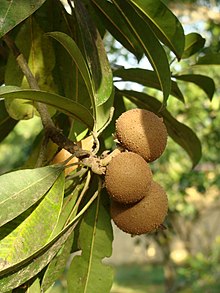| Manilkara huberi | |
|---|---|

| |
| Scientific classification | |
| Kingdom: | Plantae |
| Clade: | Tracheophytes |
| Clade: | Angiosperms |
| Clade: | Eudicots |
| Clade: | Asterids |
| Order: | Ericales |
| Family: | Sapotaceae |
| Genus: | Manilkara |
| Species: | M. huberi |
| Binomial name | |
| Manilkara huberi (Ducke) A.Chev. | |
| Synonyms | |
|
Mimusops huberi Ducke | |
Manilkara huberi, also known as masaranduba, níspero, and sapotilla, is a fruit bearing plant of the genus Manilkara of the family Sapotaceae.
Geographical distribution
Manilkara huberi is native to large parts of northern South America, Central America and the Antilles, at elevations below 800 metres (2,600 ft) above sea level.
Description
Manilkara huberi is a large tree, reaching heights of 30–55 metres (98–180 ft). The leaves are oblong, approximately 1–2 decimetres (3.9–7.9 in) in length, with yellow undersides. The flowers are hermaphroditic; white with 3 sepals. The edible fruit is yellow and ovoid, 3 centimetres (1.2 in) in diameter, containing one seed (or occasionally two).
Uses
| This section does not cite any sources. Please help improve this section by adding citations to reliable sources. Unsourced material may be challenged and removed. (May 2024) (Learn how and when to remove this message) |
The fruit of the M. huberi is similar to the sapodilla and is edible, with excellent flavor and is popular for use in desserts. Etymologically speaking, "Sapodilla" derives from the Nahuatl word "tzapotl" which refers to any sweet fruit with a soft flesh. Hence many species of Manilkara may be colloquially called "sapote" or "sapodilla" and indeed a number of unrelated fruit trees such as Pouteria sapota.
M. huberi produces an edible latex called Chicle that can be harvested in a manner similar to the harvesting of the latex of the rubber tree (Hevea brasiliensis). The latex dries to an inelastic rubber, which is considered inferior to gutta-percha.
The latex from M. huberi was used to make golf ball covers, along with that the better known and more widespread M. bidentata ("Balata" or "Massaranduba.") Latex products from a number of Manilkara species being interchangeably called "balata", "Gutta Balata", or more generally "Chicle." It was considered a good quality, but short-lived, cover, requiring frequent recoating or replacement. Balls with Balata coatings had a high spin rate. Yet it was popular in tournaments among professionals and low handicap players. Modern materials such as Polyurethane Elastomer and Methacrylic Acid copolymers have made Balata golf balls largely obsolete by the late 20th century, as they have much better abrasion resistance and generally lower air drag.
The tree is also used for lumber in Puerto Rico. The wood is red and very hard, and is popular for use in furniture making, construction, and railway ties. The wood is so dense to the point that it may not float in water, and requires pre-drilling before nailing. The specific gravity of M. huberi wood is between 0.85 and 0.95 g/cm.
Synonyms
Manilkara huberi is also known as:
- Manilkara jaimiqui C. Wright ex Griseb.; Dubard
- Mimusops huberi Ducke
- Mimusops jaimiqui C. Wright ex Griseb.
References
- "Manilkara huberi (Ducke) Standl". Plants of the World Online. The Trustees of the Royal Botanic Gardens, Kew. n.d. Retrieved April 8, 2023.
- "Manilkara huberi (Ducke) Standl". Catalogue of Life. Species 2000. n.d. Retrieved April 8, 2022.
- "Características essenciais das folhas de Manilkara huberi" [Essential characteristics of the leaves of M. huberi]. Espécies Abóreas da Amazônia. Agência de Informação Embrapa. Retrieved 23 July 2012.
- "Flores de Manilkara huberi". Espécies Abóreas da Amazônia. Agência de Informação Embrapa. Retrieved 23 July 2012.
- "Manilkara huberi". Tropicos. Retrieved 23 July 2012.
| Taxon identifiers | |
|---|---|
| Manilkara huberi | |